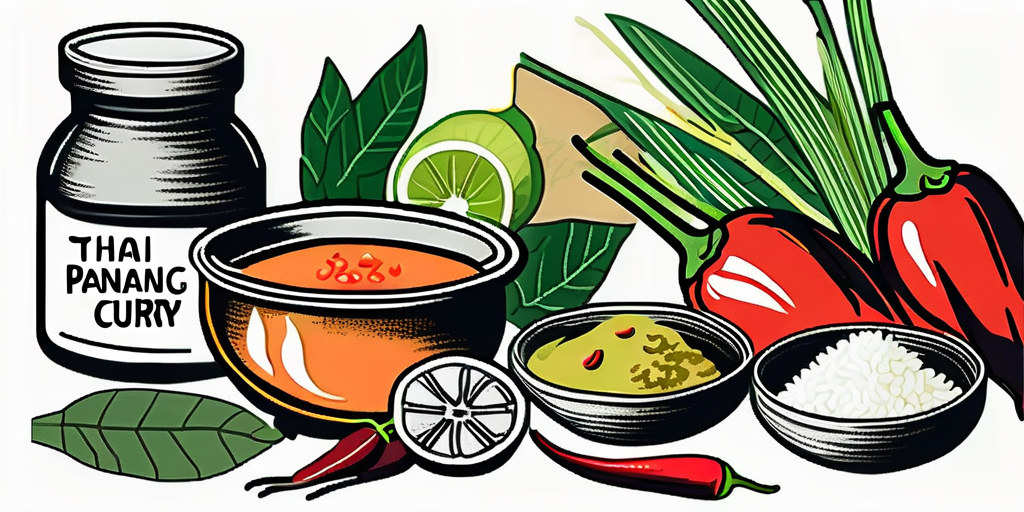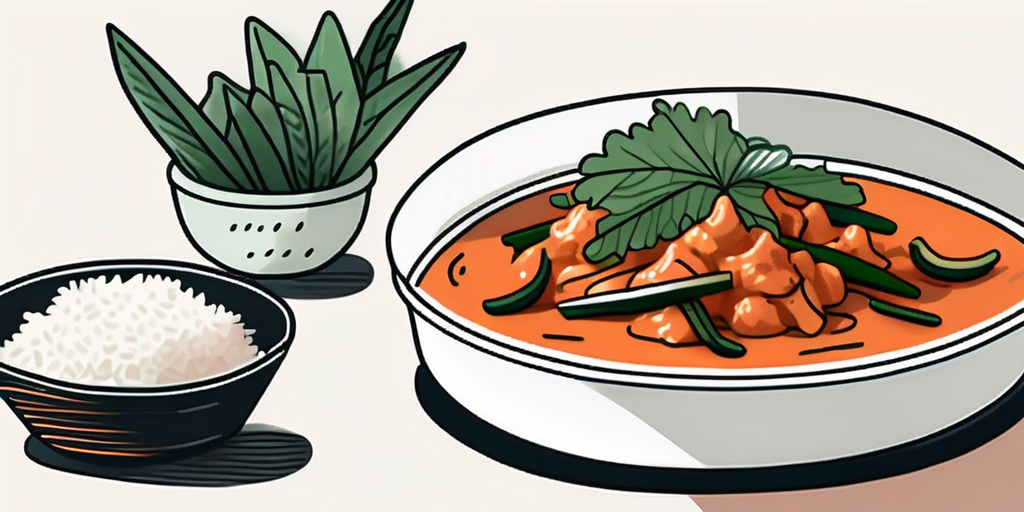Thai Panang curry is a popular and beloved dish that hails from the vibrant culinary landscape of Thailand. Renowned for its luxurious and velvety texture, tantalising aromas, and robust flavours, Panang curry has captured the hearts and taste buds of food enthusiasts worldwide. This exquisite curry is a harmonious blend of coconut milk, intricately crafted curry paste, aromatic herbs, and a symphony of spices, creating a culinary masterpiece that delights the senses.

Delving into the depths of Thai cuisine, one cannot overlook the intricate artistry that goes into creating a perfect Panang curry. Each ingredient is carefully selected to contribute its unique essence to the dish, resulting in a harmonious medley of flavours that dance on the palate. The creamy coconut milk provides a luscious base, while the curry paste infuses the dish with a depth of spice that is both bold and nuanced.
The origins of Panang curry
Panang curry, also known as Phanaeng curry, traces its roots to the sun-kissed southern region of Thailand, where culinary traditions are as rich and diverse as the landscape itself. Named after the picturesque town of Panang nestled in the Penang state of Malaysia, this curry bears the influence of Malay and Indian cuisines, resulting in a tantalising fusion of flavours that is truly exceptional.
The journey of Panang curry from its humble beginnings to international acclaim is a testament to the culinary prowess of the Thai people. Through centuries of refinement and innovation, this dish has evolved into a culinary masterpiece that continues to captivate food enthusiasts around the globe.
Key ingredients in a traditional Panang curry
A traditional Panang curry is a symphony of flavours, with each ingredient playing a crucial role in creating the perfect harmony of taste and texture. From the creamy richness of coconut milk to the aromatic notes of kaffir lime leaves and Thai basil, every component is meticulously selected to elevate the dish to culinary excellence. The subtle sweetness of palm sugar, the umami depth of fish sauce, and the succulent meat or seafood all come together to create a culinary experience that is nothing short of extraordinary.
For those seeking a plant-based alternative, fear not, as the essence of Panang curry can be preserved through the use of plant-based ingredients that capture the essence of the traditional dish. By incorporating plant-based alternatives in lieu of animal-based components, one can embark on a culinary journey that is not only delicious but also mindful of dietary preferences and ethical considerations.
Transitioning to a plant-based diet
Transitioning to a plant-based diet can have numerous health benefits. By eliminating or reducing the consumption of animal products, you can lower your risk of certain diseases such as heart disease, obesity, and type 2 diabetes. Additionally, a plant-based diet is also more sustainable and environmentally friendly.

Embracing a plant-based diet involves more than just changing what's on your plate; it's a lifestyle choice that can have far-reaching effects on your health and the environment. By focusing on whole, unprocessed plant foods such as fruits, vegetables, whole grains, nuts, and seeds, you can nourish your body with a diverse range of nutrients that support overall well-being.
Health benefits of a plant-based diet
A plant-based diet is rich in vitamins, minerals, and fiber, which are essential for maintaining optimal health. It can help lower cholesterol levels, improve digestion, and promote weight loss. Plant-based diets are also associated with a reduced risk of chronic diseases such as cancer and cardiovascular disease.
Furthermore, plant-based eating can enhance your immune system, reduce inflammation in the body, and provide a natural source of energy that can sustain you throughout the day. The abundance of antioxidants in plant foods can help combat oxidative stress and protect your cells from damage, contributing to a longer, healthier life.
Environmental impact of plant-based diets
Choosing a plant-based diet can significantly reduce your carbon footprint. Animal agriculture is a major contributor to greenhouse gas emissions, deforestation, and water pollution. By opting for plant-based alternatives, you are actively supporting sustainable food production and minimizing your impact on the environment.
Moreover, transitioning to a plant-based diet can help conserve water resources and preserve biodiversity. The intensive farming practices associated with animal agriculture not only deplete water supplies but also contribute to habitat destruction and species extinction. By embracing plant-based eating, you are contributing to the conservation of our planet's precious ecosystems and wildlife.
Ingredients for plant-based Thai Panang curry with rice
To make a delicious plant-based Thai Panang curry with rice, you will need the following ingredients:
Essential spices and herbs for Thai Panang curry
For the rich and aromatic flavors of Thai Panang curry, it is important to use the right combination of spices and herbs. Some essential ingredients include:
- Red curry paste
- Coconut milk
- Kaffir lime leaves
- Thai basil
- Palm sugar
- Soy sauce or tamari
- Lemongrass
Thai Panang curry is a delightful dish that combines the creamy richness of coconut milk with the bold flavours of red curry paste and aromatic kaffir lime leaves. Thai basil adds a fresh and peppery note, while palm sugar brings a hint of sweetness to balance the dish's spiciness. The umami depth is enhanced by the addition of soy sauce or tamari, creating a harmonious blend of flavours that is both comforting and exciting.
Choosing the right plant-based alternatives
To replace the traditional meat or seafood in this recipe, you can opt for plant-based alternatives such as tofu, tempeh, or a combination of vegetables. These alternatives provide a good source of protein and add texture to the curry.
Tempeh, made from fermented soybeans, offers a nutty flavour and a firm texture that holds up well in the rich sauce of the Panang curry. Tofu, on the other hand, is soft and absorbs the flavours of the curry beautifully, adding a creamy contrast to the dish. For a burst of colour and nutrients, a medley of vegetables like bell peppers, snow peas, and bamboo shoots can be added, bringing a delightful crunch and variety to each bite.
Step-by-step guide to making plant-based Thai Panang curry
Follow these steps to create a delicious plant-based Thai Panang curry:
Preparing your ingredients
Start by preparing your ingredients. Slice the tofu or tempeh into bite-sized pieces and chop the vegetables. Set aside the Panang curry paste, as well as the coconut milk, kaffir lime leaves, Thai basil, and palm sugar.
When it comes to making a traditional Thai Panang curry, the choice of vegetables can vary depending on personal preference and seasonal availability. Common vegetables used in this dish include bell peppers, green beans, carrots, and bamboo shoots. These vegetables not only add vibrant colours to the curry but also provide a variety of textures and flavours that complement the rich and creamy Panang sauce.
Cooking the curry and rice
Heat a large pan or wok over medium heat and add a splash of oil. Once hot, add the Panang curry paste and cook for a minute until fragrant. Add the tofu or tempeh and stir-fry for a few minutes until lightly browned. Next, add the vegetables and cook until they are tender-crisp.
Pour in the coconut milk and add the kaffir lime leaves, Thai basil, palm sugar, and soy sauce or tamari. Stir well to combine and bring the curry to a simmer. Let it cook for about 10-15 minutes, allowing the flavors to meld together.
The key to a successful Thai Panang curry lies in the balance of flavours. The creamy coconut milk provides a luscious base for the spicy Panang curry paste, while the aromatic kaffir lime leaves and Thai basil add a refreshing and citrusy note to the dish. Palm sugar is used to subtly sweeten the curry, balancing out the heat from the chillies. Additionally, the umami-rich soy sauce or tamari enhances the overall savoury profile of the curry, creating a harmonious blend of sweet, spicy, and salty flavours.
In the meantime, cook your rice according to package instructions. Once the curry and rice are cooked, remove from heat and let them cool slightly before serving.
Serving and storing your plant-based Thai Panang curry
Thai Panang curry is best served hot and fresh. You can enjoy it with steamed jasmine rice or noodles for a complete meal.

Originating from the central region of Thailand, Panang curry is known for its rich and creamy texture, infused with aromatic herbs and spices. The dish offers a perfect balance of sweetness and heat, making it a favourite among Thai food enthusiasts.
Ideal side dishes for Thai Panang curry
To complement the flavours of Thai Panang curry, you can serve it with a variety of side dishes. Some popular options include steamed vegetables, fresh cucumber slices, pickled vegetables, or a side of Thai chili sauce for an extra kick of spice.
For a more authentic experience, consider pairing your curry with a side of sticky rice or crispy roti to soak up the delicious sauce. The combination of textures and flavours will elevate your dining experience to new heights.
Tips for storing and reheating your curry
If you have leftovers, store them in an airtight container in the refrigerator for up to three days. To reheat, transfer the curry to a saucepan and gently heat over low heat, stirring occasionally, until warmed through. You may need to add a splash of water or coconut milk to thin out the curry if it thickens when refrigerated.
Embrace the culinary delights of Thailand by savouring this plant-based Thai Panang curry with rice, and transport your taste buds to the bustling streets of Bangkok without leaving the comfort of your own home.
Ready to indulge in the rich flavours of Thailand with the convenience of a quick and nutritious meal? Pam Pam offers a range of plant-based Asian ready meals that are as delicious as they are easy to prepare. Our Thai Panang curry captures the authentic essence of traditional Thai cuisine, using aromatic spices like fresh chillies, lemongrass, coriander, and cardamom.
Perfect for those busy nights or when you crave a taste of Asia, our meals are snap-frozen to lock in the flavour and nutrients, ensuring you enjoy the freshest experience possible. Shop online today and discover the convenience of Pam Pam's plant-based delights!









